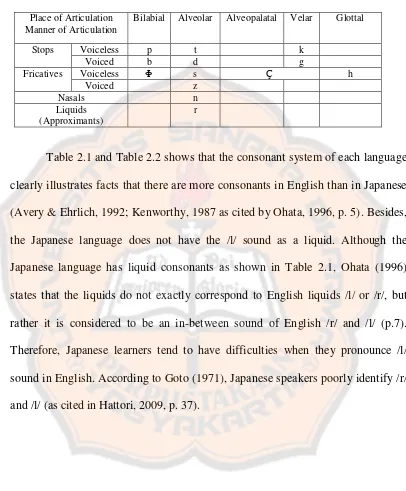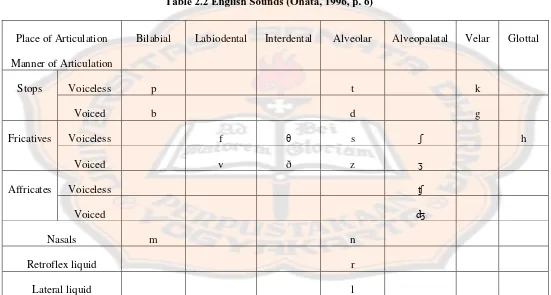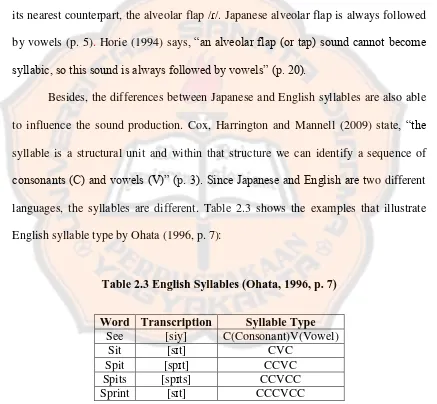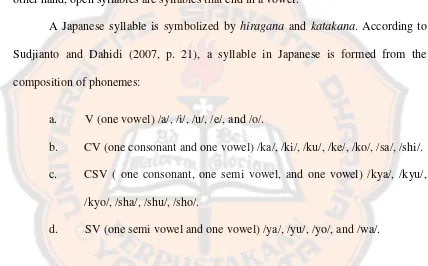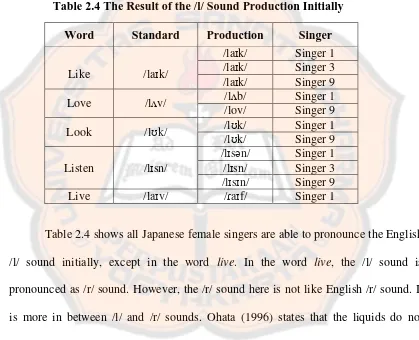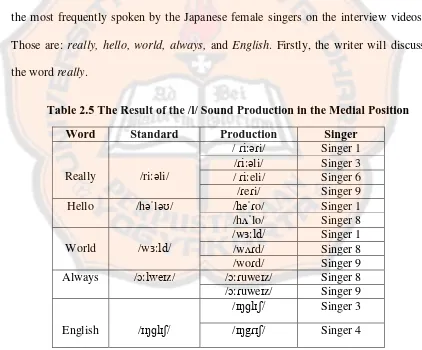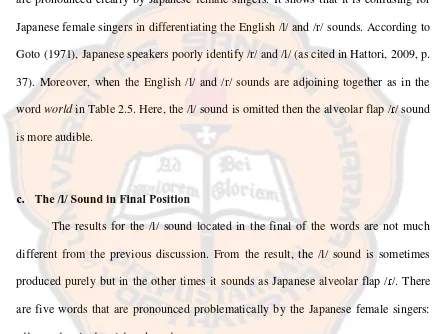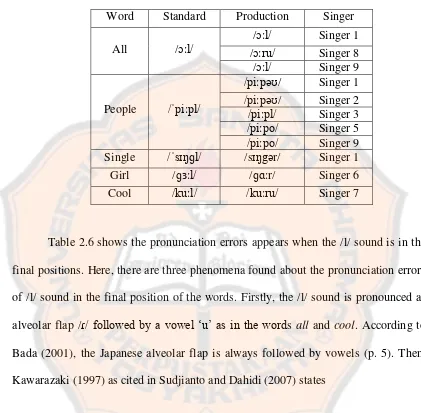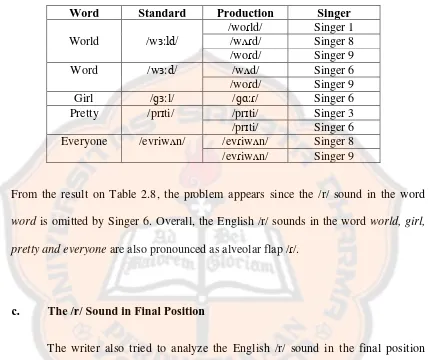ABSTRACT
Theodora, Claudia. (2015). A Study of English Liquids Produced by Japanese Female Singers on TV Shows. Yogyakarta: English Language Education Study Program, Sanata Dharma University.
This study dealt with two English liquids pronunciation: /l/ and /r/. The aims of this study were to analyze the pronunciation error of English words consisting /l/ and /r/ sounds by Japanese female singers. There were two research questions. They are: “How do the Japanese female singers pronounce the English liquids?” and “What are the causes of the English liquids /l/ and /r/ pronunciation errors among Japanese female singers?”
The method used in this study was document analysis. The documents used in this study were the transcripts of interview and reality show videos of ex-AKB48 members (Itano Tomomi), ex-members of Morning Musume (Ogawa Makoto, Ishikawa Rika, Tanaka Reina, Fujimoto Miki, and Kamei Eri), Berryz Koubou member (Momoko Tsugunaga), Utada Hikaru, and Ayumi Hamasaki which were downloaded from Youtube. Then, the English words which contained /l/ and /r/ sounds were sorted into some tables and classified into three categories based on /l/ and /r/ sounds positions in certain words: initial, medial, and final. After that, the English /l/ and /r/ pronunciation errors in word positions were analyzed by linking the English phonological theories with Japanese phonological theories.
The result of this study showed the confusion in differentiating /l/ and /r/ sounds among Japanese female singers. They tended to change the English /l/ and /r/ sounds into Japanese alveolar-flap /ɾ/ sound. In addition, the Japanese alveolar-flap /ɾ/ in some English words sometimes was pronounced by adding a vowel „ʊ‟. Moreover, the English /r/ sound in the final position of the word was vocalized. It showed the /r/ sound coalesced with the previous vowel so that the /r/ sound was omitted.
The confusion in differentiating English /l/ and /r/ sounds was because Japanese language has no /l/ sound. Japanese has only alveolar-flap /ɾ/ which is equivalent to the English /l/ and /r/ sounds. Besides, Japanese language syllable system is open syllable so there should be a vowel following the English consonant /l/ and /r/ sounds. Hence, the words could conform to the Japanese open syllable pattern (CV-CV) and could be pronounced by Japanese female singers.
ABSTRAK
Theodora, Claudia. (2015). A Study of English Liquids Produced by Japanese Female Singers on TV Shows. Yogyakarta: Program Studi Pendidikan Bahasa Inggris, Universitas Sanata Dharma.
Penelitian ini fokus pada pengucapan dua bunyi liquid bahasa Inggris: /l/ dan /r/. Tujuan dari penelitian ini adalah menganalisis kesalahan pengucapan bunyi dalam kata-kata bahasa Inggris yang terdapat bunyi /l/ dan /r/ oleh penyanyi wanita Jepang. Terdapat dua pertanyaan dalam penelitian ini, yaitu: "Bagaimana penyanyi wanita Jepang mengucapkan English liquids?" dan "Apa penyebab dari kesalahan pengucapan bunyi /l/ dan /r/ pada penyanyi wanita Jepang?"
Metode yang digunakan dalam penelitian ini adalah analisis dokumen. Dokumen yang digunakan dalam penelitian ini berupa salinan video wawancara dan reality show dari mantan anggota idol group AKB48 (Itano Tomomi), mantan anggota idol group Morning Musume (Ogawa Makoto, Ishikawa Rika, Tanaka Reina, Fujimoto Miki, dan Kamei Eri), Momoko Tsugunaga dari idol group Berryz Koubou, Utada Hikaru, dan Ayumi Hamasaki yang diunduh melalui Youtube. Kemudian, kata-kata bahasa Inggris yang mengandung bunyi /l/ dan /r/ diurutkan ke dalam beberapa tabel dan diklasifikasikan ke dalam tiga kategori berdasarkan posisi bunyi /l/ dan /r/ dalam kata-kata tertentu: di awal, di tengah, dan di akhir. Setelah itu, kesalahan pengucapan bunyi /l/ dan /r/ pada posisi dalam kata-kata dianalisa dengan menghubungkan teori fonologi bahasa Inggris dan bahasa Jepang.
Hasil penelitian ini menunjukkan kebingungan dalam membedakan bunyi /l/ dan /r/ oleh penyanyi wanita Jepang. Mereka cenderung mengubah bunyi bahasa Inggris /l/ dan /r/ ke dalam bunyi bahasa Jepang alveolar-flap /ɾ/. Selain itu, terkadang bunyi alveolar-flap /ɾ/ bahasa Jepang dalam beberapa kata-kata bahasa Inggris diucapkan dengan menambahkan vokal 'ʊ'. Bahkan, bunyi bahasa Inggris /r/ pada posisi akhir kata tersebut mengalami vokalisasi. Artinya, bunyi /r/ bergabung dengan dengan bunyi vokal sebelumnya sehingga bunyi /r/ terdengar menghilang.
Kebingungan dalam membedakan bunyi bahasa Inggris /l/ dan /r/ karena bahasa Jepang tidak memiliki bunyi /l/. Bahasa Jepang hanya memiliki alveolar-flap /ɾ/ yang setara dengan bunyi bahasa Inggris /l/ dan /r/. Selain itu, sistem suku kata bahasa Jepang adalah suku kata terbuka sehingga harus ada vokal yang mengikuti bunyi konsonan bahasa Inggris /l/ dan /r/. Oleh karena itu, kata-kata tersebut dapat sesuai dengan pola suku kata terbuka Jepang (KV-KV) dan dapat diucapkan oleh penyanyi wanita Jepang.
A STUDY OF ENGLISH LIQUIDS PRODUCED BY JAPANESE FEMALE SINGERS ON TV SHOWS
A SARJANA PENDIDIKAN FINAL PAPER
Presented as Partial Fulfillment of the Requirements to Obtain the Sarjana Pendidikan Degree
in English Language Education
By
Claudia Theodora Student Number: 101214052
ENGLISH LANGUAGE EDUCATION STUDY PROGRAM DEPARTMENT OF LANGUAGE AND ARTS EDUCATION FACULTY OF TEACHERS TRAINING AND EDUCATION
SANATA DHARMA UNIVERSITY YOGYAKARTA
i
A STUDY OF ENGLISH LIQUIDS PRODUCED BY JAPANESE FEMALE SINGERS ON TV SHOWS
A SARJANA PENDIDIKAN FINAL PAPER
Presented as Partial Fulfillment of the Requirements to Obtain the Sarjana Pendidikan Degree
in English Language Education
By
Claudia Theodora Student Number: 101214052
ENGLISH LANGUAGE EDUCATION STUDY PROGRAM DEPARTMENT OF LANGUAGE AND ARTS EDUCATION FACULTY OF TEACHERS TRAINING AND EDUCATION
SANATA DHARMA UNIVERSITY YOGYAKARTA
iv
“
He has made everything beautiful in its time; but He has
made their hearts without knowledge, so that man is unable
to see the works of God, from the first to the last.
”
~ Ecclesiastes 3:11~
I dedicate this final paper to:
My beloved family
vii ABSTRACT
Theodora, Claudia. (2015). A Study of English Liquids Produced by Japanese Female Singers on TV Shows. Yogyakarta: English Language Education Study Program, Sanata Dharma University.
This study dealt with two English liquids pronunciation: /l/ and /r/. The aims of this study were to analyze the pronunciation error of English words consisting /l/ and /r/ sounds by Japanese female singers. There were two research questions. They are: “How do the Japanese female singers pronounce the English liquids?” and “What are the causes of the English liquids /l/ and /r/ pronunciation errors among Japanese female singers?”
The method used in this study was document analysis. The documents used in this study were the transcripts of interview and reality show videos of ex-AKB48 members (Itano Tomomi), ex-members of Morning Musume (Ogawa Makoto, Ishikawa Rika, Tanaka Reina, Fujimoto Miki, and Kamei Eri), Berryz Koubou member (Momoko Tsugunaga), Utada Hikaru, and Ayumi Hamasaki which were downloaded from Youtube. Then, the English words which contained /l/ and /r/ sounds were sorted into some tables and classified into three categories based on /l/ and /r/ sounds positions in certain words: initial, medial, and final. After that, the English /l/ and /r/ pronunciation errors in word positions were analyzed by linking the English phonological theories with Japanese phonological theories.
The result of this study showed the confusion in differentiating /l/ and /r/ sounds among Japanese female singers. They tended to change the English /l/ and /r/ sounds into Japanese alveolar-flap /ɾ/ sound. In addition, the Japanese alveolar-flap /ɾ/ in some English words sometimes was pronounced by adding a vowel „ʊ‟. Moreover, the English /r/ sound in the final position of the word was vocalized. It showed the /r/ sound coalesced with the previous vowel so that the /r/ sound was omitted.
viii
ABSTRAK
Theodora, Claudia. (2015). A Study of English Liquids Produced by Japanese Female Singers on TV Shows. Yogyakarta: Program Studi Pendidikan Bahasa Inggris, Universitas Sanata Dharma.
Penelitian ini fokus pada pengucapan dua bunyi liquid bahasa Inggris: /l/ dan /r/. Tujuan dari penelitian ini adalah menganalisis kesalahan pengucapan bunyi dalam kata-kata bahasa Inggris yang terdapat bunyi /l/ dan /r/ oleh penyanyi wanita Jepang. Terdapat dua pertanyaan dalam penelitian ini, yaitu: "Bagaimana penyanyi wanita Jepang mengucapkan English liquids?" dan "Apa penyebab dari kesalahan pengucapan bunyi /l/ dan /r/ pada penyanyi wanita Jepang?"
Metode yang digunakan dalam penelitian ini adalah analisis dokumen. Dokumen yang digunakan dalam penelitian ini berupa salinan video wawancara dan reality show dari mantan anggota idol group AKB48 (Itano Tomomi), mantan anggota idol group Morning Musume (Ogawa Makoto, Ishikawa Rika, Tanaka Reina, Fujimoto Miki, dan Kamei Eri), Momoko Tsugunaga dari idol group Berryz Koubou, Utada Hikaru, dan Ayumi Hamasaki yang diunduh melalui Youtube. Kemudian, kata-kata bahasa Inggris yang mengandung bunyi /l/ dan /r/ diurutkan ke dalam beberapa tabel dan diklasifikasikan ke dalam tiga kategori berdasarkan posisi bunyi /l/ dan /r/ dalam kata-kata tertentu: di awal, di tengah, dan di akhir. Setelah itu, kesalahan pengucapan bunyi /l/ dan /r/ pada posisi dalam kata-kata dianalisa dengan menghubungkan teori fonologi bahasa Inggris dan bahasa Jepang.
Hasil penelitian ini menunjukkan kebingungan dalam membedakan bunyi /l/ dan /r/ oleh penyanyi wanita Jepang. Mereka cenderung mengubah bunyi bahasa Inggris /l/ dan /r/ ke dalam bunyi bahasa Jepang alveolar-flap /ɾ/. Selain itu, terkadang bunyi alveolar-flap /ɾ/ bahasa Jepang dalam beberapa kata-kata bahasa Inggris diucapkan dengan menambahkan vokal 'ʊ'. Bahkan, bunyi bahasa Inggris /r/ pada posisi akhir kata tersebut mengalami vokalisasi. Artinya, bunyi /r/ bergabung dengan dengan bunyi vokal sebelumnya sehingga bunyi /r/ terdengar menghilang.
Kebingungan dalam membedakan bunyi bahasa Inggris /l/ dan /r/ karena bahasa Jepang tidak memiliki bunyi /l/. Bahasa Jepang hanya memiliki alveolar-flap /ɾ/ yang setara dengan bunyi bahasa Inggris /l/ dan /r/. Selain itu, sistem suku kata bahasa Jepang adalah suku kata terbuka sehingga harus ada vokal yang mengikuti bunyi konsonan bahasa Inggris /l/ dan /r/. Oleh karena itu, kata-kata tersebut dapat sesuai dengan pola suku kata terbuka Jepang (KV-KV) dan dapat diucapkan oleh penyanyi wanita Jepang.
ix
ACKNOWLEDGEMENTS
First of all, I would like to express my great gratitude to my God, Yeshua Hamashiakh for His blessings. So many problems come and He helps me to overcome all the problems through His blessings. He has strengthened and encouraged me to finish this final paper.
I would also like to express my gratitude to my advisor, Made Frida Yulia, S.Pd., M.Pd. for the time she spent reading and giving feedback to my final paper. I also thank her for all advice and encouragement for me to finish my final paper.
My deepest gratitude is addressed to my beloved parents, Drs. Eddie Parsono and Dra. Anneke Olga Sarapung for their love, support, protection and prayer. I would also thank my beloved sisters, Maria and Elizabeth for all support they have given to me. My special gratitude is for my best friend. I thank him for his sincere love and never ending encouragement in every single time of finishing my thesis.
I would also like to thank all English Language Education Study Program lecturers for their guidance and experiences during my study in English Language Education Study Program and all secretary staff of English Language Education Study Program for being so helpful and friendly.
My special thanks are also given to my friends Martha and Clara who always helped me in the process of finishing this final paper, Tika, Mona, Gitta, Cik Wen and all English Language Education Study Program 2010 students, who have given me a lot of bitter-sweet memories and for all support, help, and time we have spent together in PBI.
Lastly, I would like to thank all people that I cannot mention one by one here, who have helped me in finishing my final paper and have drawn all memories in my life.
x
a. The /l/ Sound in Initial Position ……….
xi
b. The /l/ Sound in Medial Position ………... c. The /l/ Sound in Final Position ………..
2. The /r/ Sound ………...
a. The /r/ Sound in Initial Position ………. b. The /r/ Sound in Medial Position ……….. c. The /r/ Sound in Final Position ………. 3. The Analysis of Pronunciation Errors ……….
xii
LIST OF TABLES
Table
Table 2.1 Japanese Sounds (Ohata, 1996, p. 6) ………. Table 2.2 English Sounds (Ohata, 1996, p. 6)………
Table 2.3 English Syllables (Ohata, 1996, p. 7) ……… Table 2.4 The Results of the /l/ Sound Production Initially ……….. Table 2.5 The Results of the /l/ Sound Production in the Medial Position Table 2.6 The Results of the /l/ Sound Production in the Final Position ... Table 2.7 The Result of the /r/ Sound Production in Initial Position……. Table 2.8 The Result of the /r/ Sound Production in the Medial Position Table 2.9 The Result of the /r/ Sound Production in the Final Position…. Table 2.10 The /l/ Sound Pronunciation Errors in the Middle Position of the English Words ………..
Table 2.11 The /l/ Sound Pronunciation Errors in the Final Position of English Words ………
xiii
LIST OF APPENDICES
Appendix 1: The List of the /l/ Sound Pronunciation Produced by Japanese Female Singers ………...
Appendix 2: The List of the /r/ Sound Pronunciation Produced by Japanese Female Singers ………...
38
1 CHAPTER I INTRODUCTION
This chapter is divided into two parts, namely the research background and research method. The research background will explain the reason why the writer chooses the topic of the study. The research method will explain the description of method, theories and problem limitation.
A. Research Background
Nowadays, English has been one of the worldwide media of communication. Therefore, Kachru states that “there are more non-native than native users of English in the world” (as cited in Sasaki, Suzuki and Yoneda, 2006, p. 382). This fact shows that the English language symbolizes globalization and modernization. It means that English has been a second language and a foreign language for people in many countries. However, a problem appears when non-native speakers pronounce English words inappropriately whereas pronunciation is substantial in language skills. According to Fraser (2000) as cited in Singer (2006),
Pronunciation is arguably one of the most important of the language skills, in the sense that, with clear pronunciation, a learner can be easy to understand even when their grammar and vocabulary are not the best, while poor pronunciation can make a learner very difficult to understand even if their grammar is technically excellent (p. 12).
English as a foreign language (EFL) is taught to whom English has no function in their first language country. On the other hand, English as a second language (ESL) is taught to whom English has a function in their first language country. It can be said that non-native speakers pronunciation are influenced by their mother tongue. UNESCO, as cited in Buhmann and Trudell (2008, p.6), defines “mother tongue or mother language refers to a child’s first language, the language learned in the home from older family members.” Therefore, it will influence the non-native English speakers in speaking English especially in their pronunciation. For instance is when Japanese as non-native English speakers speak some English sounds which are not familiar in Japanese language sounds.
Japanese language has several English missing sounds. Akihiko (2014) says additionally, /l/ and /r/ are considered to be problematic pronunciations for Japanese speakers since neither of them exists in the Japanese language system (p. 59). Hence, this study will focus on production accuracies (acoustic measurement) of English liquids /l/ and /r/ sounds. A lot of researches on the pronunciation of the /l/ and /r/ sounds by Japanese in speaking English have been done by linguists.
case of delay, which is pronounced /duːreɪ/ and also in pronouncing the final /l/ in real as /r/ as well as the final /l/ in kettle. The same problem was also found in Nogita’s (2010) research. There were 93.9% of Japanese English learners’ errors
on the productions of vowels or vowels followed by /r/. It means that the English liquids /l/ and /r/ are difficult to be pronounced by Japanese. Therefore, this study will focus on the pronunciation of the English /l/ and /r/ sounds.
both English /l/ and /r/ are a challenge to discriminate and produce for Japanese Speakers of English.
In brief, the Japanese English learners have difficulties in pronouncing the English liquids in some English words. According to Chanhwall (2012), more specifically, the Japanese language has no /l/ sound but has /r/ sound. Thus Japanese learners of English are said to have difficulty pronouncing English /l/. Therefore, they substitute the English /l/ sound into Japanese /r/ sound. From the previous research above, the production of the English liquids /l/ and /r/ made by Japanese is confusing. They do not know for sure when the /l/ is purely pronounced without changing it into /r/ sound and vice versa. Ohata (1996) argues,
Although Japanese has a liquid consonant, the liquid does not exactly correspond to the English liquid /r/ or /l/, but rather it is considered to be an in-between sound of English /r/ and /l/. The exact articulation point is not specified for the Japanese /r/ sound (p. 7).
Therefore, the differences between the English and Japanese language systems will lead the study into an error analysis.
The writer used qualitative approach in this study. It covered nine random videos from YouTube. The English liquids productions were obtained from interview and reality show videos of Japanese female singers. It is because Japanese female singers are more popular than Japanese male singers. According to Jónsdóttir (2013), female groups have the advantage of being equally approachable by fans of all sexes. It means Japanese female singers are more famous than male singers. It is showed from the popularity of female idol groups such as AKB48 in the world. Therefore, the other Japanese female singers also become a public attention outside Japan, such as ex-AKB48 member Itano Tomomi, ex-Morning Musume members, Momoko Tsugunaga from Berryz Koubou, Utada Hikaru, and Ayumi Hamasaki. According to Jónsdóttir (2013), AKB48 and its other fractions have gained tremendous popularity since their debut, and AKB48 is currently overall top grossing idol group. AKB48 is the most popular idol group nowadays.
reached a certain age, but they are still idol” (as cited in Jónsdóttir, 2013, p. 19). Considering that they are all singers, they will be able to influence the Japanese people with their English pronunciation. Therefore, this study will focus on English pronunciation by Japanese female singers. Based on the problem, the writer obtains two research questions.
(1) How do the Japanese female singers pronounce the English liquids?
(2) What are the causes of the English liquids /l/ and /r/ pronunciation errors among Japanese female singers?
B. Research Method
The research was a document analysis which aimed to analyze how Japanese female singers pronounce English liquids. Ary, Jacobs, and Sorensen (2010, p. 29) state, “Document analysis focuses on analyzing and interpreting
liquid sounds were specified whether they were pronounced accurately or inaccurately. Thereafter, the /l/ and /r/ sounds were classified based on their positions in words: initial, medial, and final position. The measurement of accuracy was based on Oxford Advanced Learners’ Dictionary. From the measurement of accuracy, the Japanese female singers who pronounced the English liquids /l/ and /r/ could be discovered.
Based on the results, the English liquid sounds produced by Japanese female singers were connected to the theories of Japanese and English phonology. One of the Japanese phonology theories was stated by Reiney and Anderson-Hsieh (1993), “the fact that Japanese words of more than one syllable always follow the consonant-vowel syllable sequence that clearly shows significant characteristics of Japanese syllables, which were different from those of English” (as cited by Ohata, 1996, p. 8). Based on the analysis of the error English liquids pronunciation, how the Japanese female singers pronounced the English liquids can be noticed.
After that, the results would lead the study into the analysis of the causes /l/ and /r/ pronunciation errors among Japanese female singers. The result would be linked into Japanese and English phonology theories. Since English and Japanese are different phonologically, Horie (1994) states
(or tap) consonant /ɾ/ which is equivalent to those two English consonants (p. 1).
9 CHAPTER II DISCUSSION
This chapter consists of two sections, namely the review of related literature and data analysis. The first part explains about the theories used in this research. The second part aims to present the findings of this research.
A.Review of Related Literature
Japanese and English has vowels and consonants in its sound system. Tsujimura (1996) states that “English has twenty-four consonants and thirteen vowels. Japanese has twenty-three consonants and five vowels” (as cited in Hattori, 2009, p. 29). When two languages, English and Japanese are compared, there are some consonant phonemes which do not commonly appear in two languages. Horie (1994) claims,
Some consonants have the same places of articulation, but have different manners of articulation when we compare the consonants of two languages. For example, English has a voiced alveolar lateral consonant /l/ and a voiced alveolar glide consonant /r/, but Japanese has only one alveolar flap (or tap) consonant /ɾ/ which is equivalent to those two English consonants (p.1).
10 Table 2.1 Japanese Sounds (Ohata, 1996, p. 6)
Place of Articulation Manner of Articulation
Bilabial Alveolar Alveopalatal Velar Glottal
Stops Voiceless p t k
Voiced b d g
Fricatives Voiceless Φ s Ҫ h
Voiced z
Nasals n
Liquids (Approximants)
r
11
Table 2.2 English Sounds (Ohata, 1996, p. 6)
Place of Articulation
Manner of Articulation
Bilabial Labiodental Interdental Alveolar Alveopalatal Velar Glottal
Stops Voiceless p t k
Voiced b d g
Fricatives Voiceless f θ s ʃ h
Voiced v ð z ʒ
Affricates Voiceless ʧ
Voiced ʤ
Nasals m n
Retroflex liquid r
Therefore, Japanese female singers produce a sound that they have in their language. Japanese language has only the sound /r/. According to Bada (2001), the lateral /l/ in English, another missing sound in the Japanese sound system, may cause some articulation difficulties. Learners will probably tend to replace this sound with its nearest counterpart, the alveolar flap /ɾ/. Japanese alveolar flap is always followed by vowels (p. 5). Horie (1994) says, “an alveolar flap (or tap) sound cannot become
syllabic, so this sound is always followed by vowels” (p. 20).
Besides, the differences between Japanese and English syllables are also able to influence the sound production. Cox, Harrington and Mannell (2009) state, “the syllable is a structural unit and within that structure we can identify a sequence of
consonants (C) and vowels (V)” (p. 3). Since Japanese and English are two different
languages, the syllables are different. Table 2.3 shows the examples that illustrate English syllable type by Ohata (1996, p. 7):
Table 2.3 English Syllables (Ohata, 1996, p. 7)
Word Transcription Syllable Type See [siy] C(Consonant)V(Vowel)
Sit [s t] CVC
Spit [sp t] CCVC
Spits [sp ts] CCVCC
13 Table 2.3 shows the variety types of syllable including open and closed syllables: CV (open syllable), CVC CCVC, CCVCC, CCCVCC (closed syllable) in English language. Closed syllables are syllables that have at least one consonant following the vowel. The most common closed syllable is the CVC syllable. On the other hand, open syllables are syllables that end in a vowel.
A Japanese syllable is symbolized by hiragana and katakana. According to Sudjianto and Dahidi (2007, p. 21), a syllable in Japanese is formed from the composition of phonemes:
a. V (one vowel) /a/, /i/, /u/, /e/, and /o/.
b. CV (one consonant and one vowel) /ka/, /ki/, /ku/, /ke/, /ko/, /sa/, /shi/. c. CSV ( one consonant, one semi vowel, and one vowel) /kya/, /kyu/,
/kyo/, /sha/, /shu/, /sho/.
d. SV (one semi vowel and one vowel) /ya/, /yu/, /yo/, and /wa/.
14 (1996) states that a vowel should be inserted between consonants, so that the word can conform to the Japanese open syllable pattern (CV-CV) (p. 14). Kawarazaki (1997) as cited in Sudjianto and Dahidi (2007) states
Japanese words which are adopted from English and ended with consonant (closed-syllable), it should be changed into open-syllable by add one vowel at
the end of the words . For example, „milk‟ becomes „miruku‟, „test‟ becomes „tesuto‟, etc. Closed-syllable „t‟ and „d‟ should be followed by „o‟, and closed
-syllable „c‟, „b‟, f, „g‟, „k‟, „l‟, „m‟, „p‟, and „s‟ should be followed by „u‟ (p.
22).
Based on the theory above, the writer identifies the problem of Japanese
female singers in pronouncing English liquids /l/ and /r/. O‟Grady, Archibald,
Aronoff, and Miller (2005) conclude that “they form of a special class of consonants
known as liquids”. For example, the word hello is pronounced /hʌro/ or /hʌˈlo/. The
/l/ sound is changed into /r/. On the other hand, the /l/ sound in the final position is pronounced purely in the word well. It is different when they pronounce the word girl. The /l/ sound is changed into /r/ even though the /l/ sound in both words well and girl is in the same place, final position. Hence, this study focuses on English liquids as the object. The writer wants to see how well Japanese female singers produce these sounds.
B. Data Analysis
15 Youtube. In the reality shows and interview videos, Japanese female singers are speaking English. Besides, the Japanese female singers on the reality shows and interview video are well-known singers in Japan and outside Japan. Considering the phenomenon which is discussed in the previous paragraph, the writer tried to listen to ex-AKB48 members (Itano Tomomi), ex-Morning Musume members (Ogawa Makoto, Ishikawa Rika, Tanaka Reina, Fujimoto Miki, and Kamei Eri), Berryz Koubou member (Momoko Tsugunaga), Utada Hikaru, and Ayumi Hamasaki produce the English words with the /l/ and /r/ sounds. From the videos, the English words with /l/ and /r/ sounds are classified into three parts based on its positions in words: initial, medial, and finally. Then the accuracy measurement of English /l/ and /r/ sounds are classified into three parts based on its positions in words: initial, medial, and final produced by Japanese female singers are based on Oxford Advanced Learners’ Dictionary.
1. The /l/ Sound
16 a. The /l/ Sound in Initial Position
The writer observed how the /l/ sound is produced initially. The writer took some of words which are often pronounced by Japanese female singers. Those words are: like, love, look, listen, and live.
Table 2.4 The Result of the /l/ Sound Production Initially
Word Standard Production Singer
Like /la k/
17 Japanese English learners will probably tend to replace this sound with its nearest counterpart, the alveolar flap /ɾ/ (p. 5). From the result on Table 2.4, all the initial /l/ sounds in English words are pronounced clearly, except the /l/ sound in the word live.
b. The /l/ Sound in Medial Position
Here, there are five words that will be discussed. Those five English words are the most frequently spoken by the Japanese female singers on the interview videos. Those are: really, hello, world, always, and English. Firstly, the writer will discuss the word really.
Table 2.5 The Result of the /l/ Sound Production in the Medial Position
Word Standard Production Singer
18 Table 2.5 shows that there are some words with /l/ sound in the middle which are not pronounced clearly. It means the /l/ sound in the words is pronounced as alveolar flap /ɾ/. On the other hand, some words with /l/ sound in the middle position are pronounced clearly by Japanese female singers. It shows that it is confusing for Japanese female singers in differentiating the English /l/ and /r/ sounds. According to Goto (1971), Japanese speakers poorly identify /r/ and /l/ (as cited in Hattori, 2009, p. 37). Moreover, when the English /l/ and /r/ sounds are adjoining together as in the word world in Table 2.5. Here, the /l/ sound is omitted then the alveolar flap /ɾ/ sound is more audible.
c. The /l/ Sound in Final Position
19 Table 2.6 The Result of the /l/ Sound Production in the Final Position
Word Standard Production Singer
All /ɔːl/
Table 2.6 shows the pronunciation errors appears when the /l/ sound is in the final positions. Here, there are three phenomena found about the pronunciation errors of /l/ sound in the final position of the words. Firstly, the /l/ sound is pronounced as alveolar flap /ɾ/ followed by a vowel „u‟ as in the words all and cool. According to Bada (2001), the Japanese alveolar flap is always followed by vowels (p. 5). Then, Kawarazaki (1997) as cited in Sudjianto and Dahidi (2007) states
Japanese words which are adopted from English and ended with consonant (closed-syllable), therefore it should be changed into open-syllable by add one
vowel at the end of the words . For example, „milk‟ becomes „miruku‟, „test‟
becomes „tesuto‟, etc. Closed-syllable „t‟ and „d‟ should be followed by „o‟, and closed-syllable „c‟, „b‟, f, „g‟, „k‟, „l‟, „m‟, „p‟, and „s‟ should be followed
20 Secondly, Table 2.6 shows that the /l/ sound is omitted as in the word people. The /l/
sound is changed into vowels „u‟ and „o‟. Then, the same change of /l/ sound into
alveolar flap /ɾ/ is also found in the words single and girl.
2. The /r/ Sound
This section shows how the English /r/ sound is produced by Japanese female singers. This section will discuss the production of English /r/ sound based on its positions in words: initial, middle and final position by Japanese female singers.
a. The /r/ Sound in Initial Position
The production of English /r/ sound in the initial position made by Japanese female singers is better than the production of English /l/ sound in the initial position. It can be seen from the data taken from the videos that the production of English /l/ sound is more problematic than English /r/ sound in the initial position.
Table 2.7 The Result of the /r/ Sound Production in Initial Position
Word Standard Production Singer
Right /ra t/ /ɾa t/ Singer 1
/ɾa t/ Singer 9 Really /riːəli/
/ɾiːeɾi/ Singer 1 / ɾiːeɾi/ Singer 6 / ɾiːəli/ Singer 3 /ɾeɾi/ Singer 9 Refrigerator /rˈfr dʒəre tə(r)/ /ɾ ˈfr dʒere tɑː/ Singer 7
Rain /re n/ /ɾe n/ Singer 2
21 From the result in Table 2.7, the pronunciation of English /r/ sound is audible clearly, even though the English /r/ sound is pronounced as alveolar flap /ɾ/ sound. Because Japanese language has only /ɾ/ in their sound, the English /r/ sound is considered the same as Japanese alveolar flap /ɾ/. Horie (1994) claims
Some consonants have the same places of articulation, but have different manners of articulation when we compare the consonants of two languages. For example, English has a voiced alveolar lateral consonant /l/ and a voiced alveolar glide consonant /r/, but Japanese has only one alveolar flap (or tap) consonant /ɾ/ which is equivalent to those two English consonants (p.1).
b. The /r/ Sound in Medial Position
22 Table 2.8 The Result of the /r/ Sound Production in the Medial Position
Word Standard Production Singer
World /wɜːld/
/woɾld/ Singer 1 /wʌɾd/ Singer 8 /woɾd/ Singer 9
Word /wɜːd/ /wʌd/ Singer 6
/woɾd/ Singer 9
Girl /ɡɜːl/ /ɡɑːɾ/ Singer 6
Pretty /pr ti/ /pr ti/ Singer 3
/pr ti/ Singer 6 Everyone /evriwʌn/ /evɾiwʌn/ Singer 8 /evɾiwʌn/ Singer 9
From the result on Table 2.8, the problem appears since the /r/ sound in the word word is omitted by Singer 6. Overall, the English /r/ sounds in the word world, girl, pretty and everyone are also pronounced as alveolar flap /ɾ/.
c. The /r/ Sound in Final Position
23 Table 2.9 The Result of the /r/ Sound Production in the Final Position
Word Standard Production Singer
More /mɔːr/ sounds are omitted by Japanese female singers. In the English language system, the /r/ sounds in the final position of the words are usually vocalized. It shows that the /r/ sound is vocalized in the final of the words if there is a vowel before it. According to
Knowles (1987), “what has happened is that a short vowel has coalesced with a
following /r/ to produce new varieties of long vowel” (as cited in Akihiko, 2014, p.
63).
3. The Analysis of the Pronunciation Errors
24 of the English words. It happens because there are some differences in sound systems of English and Japanese languages that influence Japanese female singers in pronouncing English /l/ sounds. On the other hand, the English /r/ sound is clearly pronounced initially and mostly medial. However, the /r/ sounds in the final position of the English words are often omitted. For all, the writer will try to analyze the causes of the English /l/ sound pronunciation errors by Japanese female singers in the initial and medial positions. Besides, the writer will analyze why the /r/ sound is omitted in the final position of the words by Japanese female singers. The writer takes some of the words which are problematically pronounced by Japanese female singers from the result.
a. The English /l/ Sound
25 Table 2.10 The /l/ Sound Pronunciation Errors in the Middle Position of
English Words
Table 2.10 shows the /l/ sound is pronounced as alveolar flap /ɾ/ in the words really, hello, and English. Actually, the main cause is that there is no /l/ and /r/ sounds in the Japanese language sound system. According to Akihiko (2014),
“Additionally, /l/ and /r/ are considered to be problematic pronunciation for Japanese
speakers since neither of them exists in the Japanese language system” (p. 59). However, Horie (1994) says, “English has a voiced alveolar lateral consonant /l/ and
a voiced alveolar glide consonant /r/” (p. 17). At the same time, in order to pronounce
the English /l/ sound, Akihiko (2014) states, “instead, the alveolar flap /ɾ/ is usually
substituted for both /l/ and /r/ English sound” (p. 59). Akihiko‟s statement is also
supported by Horie (1994),
26 Then, based on the differences of English and Japanese /l/ and /r/ sound systems, both English /l/ and /r/ sounds are pronounced as Japanese alveolar flap /ɾ/. According to Suski (1931), Japanese English learners produce a single liquid voiced consonant that combines the two sounds of /l/ and /r/ as it is produced by a very quick tap (also called a flap) of the tongue tip on the alveolar ridge (as cited in Smith, 2012, p. 202). Because in Japanese sound system there is no /l/ sound, Japanese female singers pronounce the English /l/ and /r/ sounds as Japanese alveolar-flap /ɾ/.
According to Smith (2012), “learners had some difficulty with pronouncing /l/ and /r/
sounds as in the case of delay, which is pronounced /du:ɾei/. This issue stems for the
lack of a separate /r/ and /l/ sound” (p. 202). It shows that Japanese female singers
had difficulty to differentiate the English /l/ and /r/ sounds. Therefore, they pronounce the /l/ sound more like Japanese alveolar-flap /ɾ/. The lack of ability to differentiate the /l/ and /r/ sounds also found when the /l/ and /r/ sounds are adjoining together in the word world. From Table 2.20, it can be seen that Singer 8 and Singer 9 pronounce the /r/ sound then omit the /l/ sound. Because it is difficult to differentiate the /l/ and /r/ sounds, the /l/ sound is also pronounced as alveolar flap /ɾ/.
27 by consonant is called heionsetsu (closed syllable)” (p.22). Therefore, when pronouncing English word which is ended by consonant (closed syllable), there should be a vowel following the consonant. As in the word always, there are two
consonants adjoining together: „l‟ and „w‟. Ohata (1996) states, inserting a vowel
between consonants, so that the word can conform to the Japanese open syllable pattern (CV-CV) (p. 14). As a consequence, the word always is pronounced as
/ˈɔruwe z/ by Singer 8 and Singer 9. From the Singer 8 and Singer 9‟s pronunciation,
the /ɾ/ sound is followed by vowel „ʊ‟. Kawarazaki (1997) as cited in Sudjianto and Dahidi (2007) states,
Japanese words which are adopted from English and ended with consonant (closed-syllable), therefore it should be changed into open-syllable by add one vowel at the end of the words . For example, „milk‟ becomes „miruku‟, „test‟
becomes „tesuto‟, etc. Closed-syllable „t‟ and „d‟ should be followed by „o‟, and closed-syllable „c‟, „b‟, f, „g‟, „k‟, „l‟, „m‟, „p‟, and „s‟ should be followed
by „u‟ (p. 22).
28 Table 2.11 The /l/ Sound Pronunciation Errors in the Final Position of
English Words
Word Word
Production
Standard Sound Changes Singer All /ɔːɾu/ /ɔːl/ /l/ becomes /ɾ/,
Firstly, the /l/ sound changed into /r/ sound and was followed by a vowel „ʊ‟. Table 2.11 shows that the /l/ sound in the word all and cool is pronounced as /ɾ/ and
followed by a vowel „ʊ‟. Both all and cool are ended with consonant „l‟, so it means
that the words all and cool are closed syllable. Kawarazaki (1997) as cited in Sudjianto and Dahidi (2007, p. 22) claims that closed-syllable „t‟ and „d‟ should be
followed by „ɔ‟, and closed-syllable „c‟, „b‟, f, „g‟, „k‟, „l‟, „m‟, „p‟, and „s‟ should be
followed by „ʊ‟.
Secondly, the /l/ sound error was also found in the word people /piːpl/. From Table 2.11, the vocalization of the /l/ sound in the word people can be seen.
According to Johnson and Britain (2003), “the /l/ vocalization is equivalent to the
29 consonant and before a vowel (Vizental, 2008, p. 79). Besides, the /l/ sound in the word people is also located in syllable rhyme. According to Harrington and Manell
(2008), “rhyme is all phonemes from the vowel to the end of the syllable.” Here, the
syllable rhyme for the word people /piːpl/ is /iːpl/. According to Akihiko (2014), “/l/
in a syllable rhyme can become like a vowel or an approximant; e.g, it will be „u‟, „o‟,
or „w‟” (p. 63). From Table 2.11, the /l/ sound in the word people is pronounced like
a vowel „u‟. Besides, the /l/ sound in the word single /sŋɡl/ is also dark / / because
the /l/ sound occurs after a consonant „g‟ and before a vowel „e‟. Then it is also located in syllable rhyme; /ŋɡl/. Although the /l/ sounds in the words, people and single are in the same environment, the results of the sound production are different. Table 2.11 shows that the /l/ sound in the word single is changed into an alveolar approximant flap /ɾ/. From those two words, people and single, it can be concluded that the change of dark / / in the syllable rhyme can be like a vowel and an approximant (alveolar flap /ɾ/).
30 (as cited in Hattori, 2009, p. 39). Therefore, because of the problems of identifications, the /l/ sound is pronounced as alveolar flap/tap /ɾ/.
b. The English /r/ Sound
The result in Table 2.12 shows that the English /r/ sounds produced by Japanese female singers are pronounced correctly in the initial and middle positions. It is because the Japanese sound system has an alveolar which is called Japanese alveolar flap /ɾ/ to substitute the English /r/ sound. Suski (1931) states that Japanese produce a single liquid voiced consonant that combines the two sounds of /l/ and /r/ as it is produced by a very quick tap (also called a “flap”) of the tongue tip on the
alveolar ridge” (as cited in Smith, 2012, p. 202). Therefore, the English /r/ sound in
31 Table 2.12 The /r/ Pronunciation Errors in the Middle and Final Position
of English Words
Firstly, the writer will discuss the result of the /r/ sound pronunciation in the final position of the words. The /r/ sound in the word word is located before a
consonant „d‟, then it is pronounced as /wɑ:d/ by Singer 6. In the English language
system itself, according to Trudgill (1999), “however, /r/ came to be dropped where it
occurred before a consonant as in arm” (as cited in Akihiko, 2014, p. 63). From Table
2.12, the /r/ sound in the word word is dropped. Therefore, it sounds like it is omitted.
However, in the word more, the /r/ sound is omitted too. Table 2.12 shows that the /r/ sound in the word more is omitted when it is pronounced by Singer 6 and Singer 7. They pronounce it as /mɔːɑ/, whereas based on Oxford Advanced Learners’ Dictionary standard, the word more should be pronounced /mɔːr/. Here, the /r/ sound
is located after a long vowel „ɔː‟. According to Carruthers (2006), “those ending in
32 The same thing also happens in the /r/ sound in the word refrigerator, after, and power. The /r/ sound is also replaced by long vowels /a/. According to Carruthers (2006), “the combination of a vowel plus /r/ is generally pronounced /a/” (p. 20).
Because the English /r/ sound in the final position is vocalized, Japanese female singers are able to pronounce the English words which are ended by
consonant „r‟. Since Japanese language syllable system is an open syllable, it means
33
CHAPTER III
CONCLUSIONS AND RECOMMENDATIONS
This chapter presents the conclusions and recommendations. There are some findings that can be concluded in this study. Then, the researcher presents the recommendations related to this study.
A. Conclusions
This section is aimed to summarize the major findings of this study. This study focused on analyzing the English liquids /l/ and /r/ sounds produced by Japanese female singers. Besides, the causes of English /l/ and /r/ pronunciation errors are identified.
From the results of the research, some important points can be concluded. First thing to be concluded is that the difficulty in distinguishing the English /l/ and /r/ sound is found among Japanese female singers. The result shows that most of Japanese female singers pronounce the English liquids /l/ sound more inconsistently than pronouncing English liquids /r/ sound. Japanese female singers are able to pronounce the /l/ sound in initial position as in Oxford Advanced Learners’ Dictionary standard. The problem appears when Japanese female
position was also pronounced like a vowel ‘u’ as in the word people. It is because the English /l/ sound in the word people is dark /ɫ/ and located in syllable rhyme.
On the other hand, there is no significant problem in the pronunciation of /r/ sound among Japanese female singers. Although the /r/ sound sounds more as Japanese alveolar-flap /ɾ/ in the initial and the medial positions of the words, the audience still understands the words which are uttered by Japanese female singers. Moreover, the /r/ sounds in the final of the words were not pronounced by Japanese female singers, but the listeners are still able to perceive the words. It is because in the English language system, the /r/ sound is commonly vocalized in the final position of the words. It means that the /r/ sound is coalesced with a vowel before it. Therefore, the /r/ sounds in the final position of the words were pronounced as a vowel. Here, the /r/ sound is corresponded with Japanese language syllable system which is open syllable.
B. Recommendations
are totally different, it also refers to two different words and meanings. Thus, the Japanese English learners are suggested also to practice more carefully and frequently in pronouncing English /l/ and /r/ sound.
36
education (8thed). Belmont: Wadsworth
Bada, E. (2001). Nativelanguage influence on the production English sounds by Japanese learners.Retrieved on September 17, 2014, from http://www.readingmatrix.com/articles/bada/article.pdf
Bühmann, D., &Trudell, B.(2008).Mother tongue matters: Local language as a key to effective learning. Retrieved on December 15, 2014 from http://unesdoc.unesco.org/images/0016/001611/161121e.pdf
Carruthers, S. W. (2006). Pronunciation difficulties of Japanese speakers of English: Predictions based on a contrastive analysis. Retrieved on
November 26,
2014,fromhttp://www.hpu.edu/CHSS/LangLing/TESOL/ProfessionalDeve lopment/200680TWPfall06/05Carruthers_Phono.pdf
Chanhwall.(2012, September). Contrastive analysis of Japanese and English liquid sounds.Retrieved on June 8, 2013, from
Hattori, K. (2009). Perception and production of English /r/-/l/ by adult Japanese
speakers.Retrieved on October 23, 2014, from
http://discovery.ucl.ac.uk/19204/1/19204.pdf
Hornby, A. S. (1995). Oxford advanced learner’s dictionary (5thed.). Oxford:
linguistics an introduction (5thed.).Boston: Bedford/St. Martin’s.
Ohata, K. (1996). Phonological differences between Japanese and English: several potentially problematic areas of pronunciation for Japanese esl/efl learners. Retrieved on September 16, 2014, from http://www.asian-efl-journal.com/Dec_04_ko.pdf
Sasaki, M., Suzuki, T., &Yoneda, M. (2006).English as an international language in non-native settings in an era of globalization. Retrievedon August 10,
2013, from
http://www.social-sciences-and-humanities.com/PDF/documents/English-as-an-international-language.pdf
Singer, J. (2006). Uncovering factors that influence English pronunciation of native Somali speakers.Retrieved on July 10, 2013, from http://www.hamline.edu/WorkArea/DownloadAsset.aspx?id=2147490899
Smith, B. (2012). Pronunciation patterns of Japanese learners and their implications for teaching.Retrieved on October 8, 2013, from http://jairo.nii.ac.jp/0026/00003710/en
Sudjianto&Dahidi, A. (2007). Pengantar linguistik bahasa Jepang. Bekasi: Kesaint Blanc.
Vizental, A. (2010) Phonetics and phonology an introduction. Retrieved on March
13, 2015, from
38 APPENDIX 1
The List of the /l/ Sound Pronunciation Produced by Japanese Female Singers Initial
Word Standard Production Singer
Middle
Word Standard Pronunciation Singer
Middle
Word Standard Pronunciation Singer
English /ɪŋɡlɪʃ/ /ɪŋɡlɪʃ/
Singer 3 Following /f ːloʊɪŋ/ /f ːloʊɪŋ/
Album /ælbəm/ /ælbəm/
Felt /felt/ /felt/
Blessed /blesɪd/ /blesɪd/ Pleasantly /plezntli/ /plezntli/
Reliable /rɪˈlaɪəbl/ /rɪˈlaɪəbl/
Walks /wɔːks/ /wɔːlks/
Galleries /ɡæləris/ /ɡæləris/
Old /əʊld/ /oʊld/
Really /ri:əli/ /ri:əli/
Novel /n vl/ /n vəl/
Family /fæməli/ /fæməli/
Actually /æktʃuəli/ /æktʃuəli/
Plan /plæn/ /plen/
Dollars /dɔːlə(r)/ /dɔːlərs/
Glad /glæd/ /glæd/
Explain /ɪkˈspleɪn/ /ekˈspleɪn/
Singer 9
Told /təʊld/ /tɔːld/
Album /ælbəm/ /albəm/
Middle
Word Standard Pronunciation Singer
Similar /sɪmələ(r)/ /sɪmɪlə/
Singer 9 Child /tʃaɪld/ /tʃaɪld/
Adult /ædʌlt/ /ədʌlt/
Really /rɪəli/ /’ reɾɪ /
World /wɜːrld/ /woɾd/
Final
Word Standard Pronunciation Singer
Final
Word Standard Pronunciation Singer
Thankful /θæŋkfl/ /θæŋkfəl/ Singer 3
All /ɔːl/ /ɔːl/
Will /wɪl/ /wɪl/
Singer 9
People /piːpl/ /piːpəʊ/
Until /ənˈtɪl/ /anˈtɪ/
Real /riːəl/ /riːl/
All /ɔːl/ /ɔːl/
Example /ɪgˈz ːmpl/ /egˈz ːmpəl/
Cool /kuːl/ /kuːl/
APPENDIX 2
The List of the /r/ Sound Pronunciation Produced by Japanese Female Singers Initial
Word Standard Pronunciation Singer
Right /raɪt/ /raɪt/
Singer 1 Really /rɪəli/ /ɾieɾi/
Rain /reɪn/ /ɾeɪn/ Singer 2
Repeat /rɪˈpiːt/ /ɾɪˈpiːto/ Singer 4
Really /rɪəli/ /ɾɪeri/ Singer 6
Refrigerator /rɪˈfrɪdʒəreɪtər/ /ɾɪˈfrɪdʒereɪtʌ/ Singer 7 Recording /rɪˈkɔːrdɪŋ/ /reˈkɔːrdɪŋ/
Singer 3
Really /rɪəli/ /rɪəli/
Read /riːd/ /riːd/
Rose /rəʊz/ /roʊz/
Right /raɪt/ /ɾaɪt/
Singer 9
Reach /riːtʃ/ /ɾiːtʃ/
Real /riːəl/ /ɾiːl/
Really /rɪəli/ /ɾeɾi/ Respect /rɪˈspekt/ /ɾɪˈspekt/
Middle
Word Standard Pronunciation Singer
Project /pr ːdʒekt/ /pɾodʒekt/
Singer 1 Appreciate /əˈpriːʃieɪt/ /əˈpɾeʃiet/
Nervous /nɜːrvəs/ /nɜːɾvəs/ Universal /juːnɪˈvɜːrsl/ /juːnɪˈvɜːɾsʌɾ/
Around /əˈraʊnd/ /oˈɾaʊnd/
World /wɜːrld/ /woɾld/
Course /kɔːrs/ /kɔːs/
Working /wɜːrkɪŋ/ /wɜːkɪŋ/
Effort /efərt/ /efəɾə/
Very /veri/ /veɾi/
Energy /enərdʒi/ /enədʒi/ Preference /prefrəns/ /pɾefrəs/ Yesterday /jestərdeɪ/ /jestəɾdeɪ/
Singer 2 Umbrella /ʌmˈbrelə/ /ʌmˈbrela/
Party /p ːrti/ /p ːti/ Singer 5
Driver /draɪvər/ /doraɪvʌɾ/
Singer 6
Word /wɜːrd/ /w :d/
Girl /ɡɜːrl/ /ɡʌɾ/
Pretty /prɪti/ /pɾɪti/
Middle
Word Standard Pronunciation Singer
Everyone /evriwʌn/ /evɾiwʌn/
Singer 8
World /wɜːrld/ /wʌɾd/
Internet /ɪntərnet/ /ɪntənet/ Lovers /lʌvərs/ /lʌvʌs/ American /əˈmerɪkən/ /əˈmerɪkən/
Singer 3 Previous /priːviəs/ /priːviəs/
Experimental /ɪkˌsperɪˈmentl / /ekˌsperɪˈmentl / Underground /ʌndərˈɡraʊnd/ /ʌndərˈɡraʊnd/
Mainstream /meɪnstriːm/ /meɪnstriːm/
Urban /ɜːrbən/ /ɜːrbən/
General /dʒenrəl/ /dʒenrəl/
First /fɜːrst/ /fɜːrst/
Surprise /sərˈpraɪz/ /sərˈpraɪz/ Inspiration /ɪnspəˈreɪʃn/ /ɪnspəˈreɪʃn/
Dramas /dr ːməs/ /dr ːm s/
Person /pɜːrsn/ /pɜːrsn/
Pretty /prɪti/ /prɪti/
Middle
Word Standard Pronunciation Singer
Stress /stres/ /stres/
Singer 3 Order /ɔːdə(r)/ /ɔːrdər/
Stores /stɔː(r)s/ /stɔːrs/
Performance /pəˈfɔːməns/ /pərˈfɔːrməns/
Crush /krʌʃ/ /krʌʃ/
Merry /meri/ /meri/
Christmas /krɪsməs/ /krɪsməs/ Forbidden /fəˈbɪdn/ /fɔːrbɪdən/
Dollars /dɔːlə(r)/ /dɔːlərs/ Promotional /prəməʊʃənl/ /prəmoʊʃɪənl/
Everyone /evriwʌn/ /evriwʌn/
Are / ː(r)/ / ːr/
Appearances /əˈpɪərəns/ /əˈpɪərəns/
Brown /braʊn/ /braʊn/
Secret /siːkrət/ /ʃiːkret/
Singer 9 Everyone /evriwʌn/ /evɾiwʌn/
Course /kɔːs/ /kɔːs/
Heart /h ːt/ /həɾt/
Inspiration /ɪnspəˈreɪʃn/ /ɪnspəˈɾeɪʃən/
Middle
Word Standard Pronunciation Singer
Word /wɜːd/ /woɾd/
Singer 9 Forever /fərˈevə(r)/ /fɔːɾˈevə/
Problem /pr bləm/ /pɾobləm/
Work /wɜːrk/ /wɔːk/
Hard /h ːd/ /həɾd/
Workahohic /wɜːkəˈh lɪk/ /wɔːkʌˈholɪk/
March /m ːtʃ/ /m ːɾtʃ/
World /wɜ:ld/ /woɾd/
Tomorrow /təˈm rəʊ/ /tu'moɾoʊ/ Control /kənˈtrəʊl/ /konˈtɾoʊl/
Present /preznt/ /pɾeznt/
Everything /evriθɪŋ/ /evɾiθɪŋ/
Final
Word Standard Pronunciation Singer
Final
Word Standard Pronunciation Singer
Neither /naɪðə(r)/ /naɪðə(r)/
Singer 3
Nor /nɔː(r)/ /nɔː(r)/
Outsider /aʊtˈsaɪdə(r)/ /aʊtˈsaɪdə(r)/ Whatever /w tˈevə(r)/ /w tˈevə(r)/
Your /jɔː(r)/ /jɔːr/
Actor /æktə(r)/ / ktər/
Order /ɔːrdə(r)/ /ɔːrdər/
Ever /evə(r)/ /evər/
Bear /beə(r)/ /beər/
Foreigner /f rənə(r)/ /f rənər/ Sugar /ʃʊgə(r)/ /ʃʊgər/ Similar /sɪmələ(r)/ /sɪmɪlə/
Singer 9 Forever /fərˈevə(r)/ /fɔːɾˈevə/
Her /hə(r)/ /həɾ/
Others /ʌðə(r)/ /ʌðəɾs/
Final
Word Standard Pronunciation Singer
Anywhere /enɪweə(r)/ /enɪweɾ/
Singer 9 Future /fjuːtʃə(r)/ /fjuːtʃəɾ/
